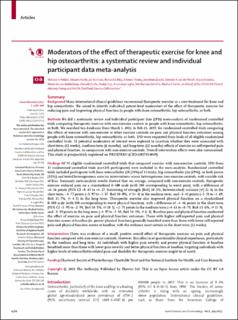| dc.description.abstract | Background: Many international clinical guidelines recommend therapeutic exercise as a core treatment for knee and hip osteoarthritis. We aimed to identify individual patient-level moderators of the effect of therapeutic exercise for reducing pain and improving physical function in people with knee osteoarthritis, hip osteoarthritis, or both.
Methods: We did a systematic review and individual participant data (IPD) meta-analysis of randomised controlled trials comparing therapeutic exercise with non-exercise controls in people with knee osteoathritis, hip osteoarthritis, or both. We searched ten databases from March 1, 2012, to Feb 25, 2019, for randomised controlled trials comparing the effects of exercise with non-exercise or other exercise controls on pain and physical function outcomes among people with knee osteoarthritis, hip osteoarthritis, or both. IPD were requested from leads of all eligible randomised controlled trials. 12 potential moderators of interest were explored to ascertain whether they were associated with short-term (12 weeks), medium-term (6 months), and long-term (12 months) effects of exercise on self-reported pain and physical function, in comparison with non-exercise controls. Overall intervention effects were also summarised. This study is prospectively registered on PROSPERO (CRD42017054049).
Findings: Of 91 eligible randomised controlled trials that compared exercise with non-exercise controls, IPD from 31 randomised controlled trials (n=4241 participants) were included in the meta-analysis. Randomised controlled trials included participants with knee osteoarthritis (18 [58%] of 31 trials), hip osteoarthritis (six [19%]), or both (seven [23%]) and tested heterogeneous exercise interventions versus heterogeneous non-exercise controls, with variable risk of bias. Summary meta-analysis results showed that, on average, compared with non-exercise controls, therapeutic exercise reduced pain on a standardised 0–100 scale (with 100 corresponding to worst pain), with a difference of –6·36 points (95% CI –8·45 to –4·27, borrowing of strength [BoS] 10·3%, between-study variance [τ2] 21·6) in the short term, –3·77 points (–5·97 to –1·57, BoS 30·0%, τ2 14·4) in the medium term, and –3·43 points (–5·18 to –1·69, BoS 31·7%, τ2 4·5) in the long term. Therapeutic exercise also improved physical function on a standardised 0–100 scale (with 100 corresponding to worst physical function), with a difference of –4·46 points in the short term (95% CI –5·95 to –2·98, BoS 10·5%, τ2 10·1), –2·71 points in the medium term (–4·63 to –0·78, BoS 33·6%, τ2 11·9), and –3·39 points in the long term (–4·97 to –1·81, BoS 34·1%, τ2 6·4). Baseline pain and physical function moderated the effect of exercise on pain and physical function outcomes. Those with higher self-reported pain and physical function scores at baseline (ie, poorer physical function) generally benefited more than those with lower self-reported pain and physical function scores at baseline, with the evidence most certain in the short term (12 weeks).
Interpretation: There was evidence of a small, positive overall effect of therapeutic exercise on pain and physical function compared with non-exercise controls. However, this effect is of questionable clinical importance, particularly in the medium and long term. As individuals with higher pain severity and poorer physical function at baseline benefited more than those with lower pain severity and better physical function at baseline, targeting individuals with higher levels of osteoarthritis-related pain and disability for therapeutic exercise might be of merit. | en_US |

